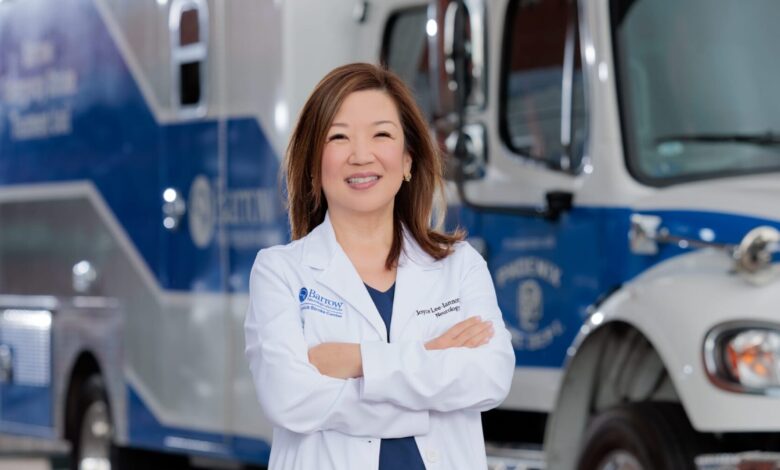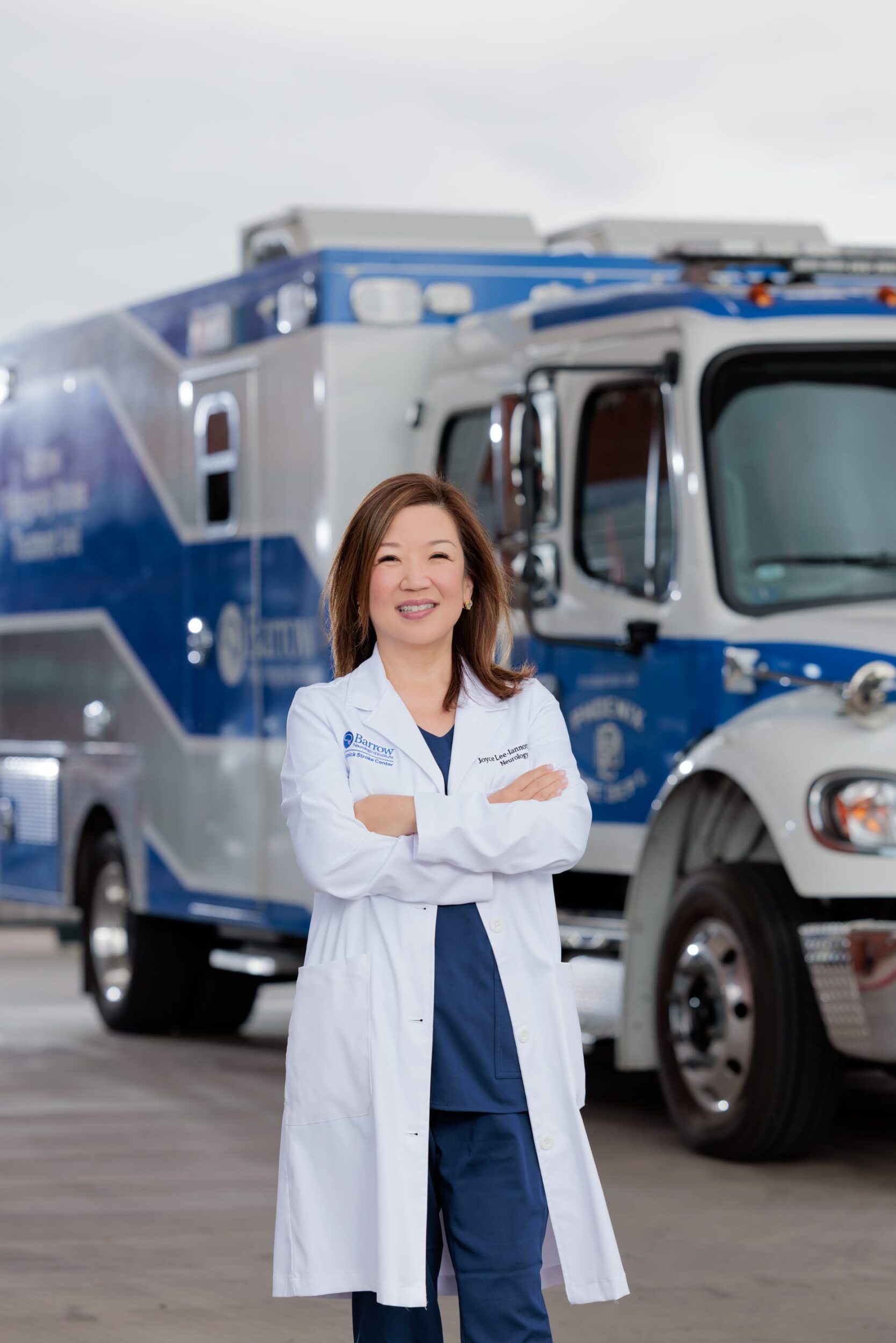In the Stroke Trenches | Sleep Review

By Sree Roy
For decades, sleep physicians have watched from the sidelines as stroke patients cycle through hospital stays with undiagnosed comorbid sleep disorders. The disconnect has been frustrating: while sleep specialists understand the vascular implications of sleep disorders, stroke neurologists have traditionally focused on the immediate crisis, leaving sleep for outpatient discussion “later,” if at all.
But change is happening, and it’s being driven by physicians like Joyce K. Lee-Iannotti, MD, FAASM, FAAN—one of a handful of clinicians board-certified in both sleep medicine and stroke neurology. Her experience offers a roadmap for sleep physicians seeking to expand their influence in stroke prevention, while highlighting just how much work remains.
In March 2025, Lee-Iannotti became the inaugural division chief of the comprehensive Sleep Center at Barrow Neurological Institute in Phoenix, as well as interim division chief of Petznick Stroke Center at Barrow. As her journey reveals, changing clinical practice patterns requires prioritizing sleep in the days following a seminal stroke, access to multidisciplinary care, and much more research into the relationship between strokes and sleep.
How to Broach Sleep Apnea
After years of focusing on a sleep practice, returning to the stroke trenches was a draw for Lee-Iannotti. But, pretty quickly, she encountered a problem. It turns out that people do not want to broach sleep in the immediate aftermath of a stroke. Approaching overwhelmed, frightened stroke patients on their first day in Barrow Neurological Institute’s hospital about obstructive sleep apnea (OSA) diagnostics was resulting in patients rebuffing sleep testing services.
A breakthrough came after speaking to investigators at other sites also recruiting for Sleep SMART, a clinical trial to determine whether treatment of OSA with CPAP after acute ischemic stroke or high-risk transient ischemic attack reduces recurrent stroke, acute coronary syndrome, and all-cause mortality over the next six months.
And the solution was elegantly simple: wait 24 hours. “We started approaching them the second day, where now we have a rapport,” Lee-Iannotti says. “We say, ‘You’re now stable. We’re going to help you prevent another stroke,’” and advises them to prioritize sleep apnea diagnostics and treatment. Recruitment started increasing.
The trial’s design allows for home sleep studies to be conducted in the hospital, CPAP titration with multiple mask trials, and immediate treatment initiation—overall, a streamlined workflow. “And now we don’t have to wait to see the patient in the outpatient setting, which could be a delay of a month to three months,” Lee-Iannotti says. “It is really refreshing.”
Comprehensive Sleep Center
Lee-Iannotti will also be in the position to help those stroke patients, and many others, longitudinally at a comprehensive Sleep Center, currently under construction. “I started a sleep lab about 12 years ago, but I feel like I am better equipped to start a sleep lab now with innovative technologies that I didn’t know about years ago,” she says.
Technologies to be housed within the 7,000-sq-ft sleep lab, slated to open at Barrow Neurological Institute in spring 2026, include high-definition infrared cameras (two per room), transcutaneous carbon dioxide monitors, and full electroencephalogram montages.
“The message to patients is: You’re welcome here, not just for sleep apnea, but for your insomnia, restless legs, REM sleep behavior disorder, nocturnal seizures. We will help you sleep, for all of your sleep disorders from A to Z,” Lee-Iannotti says.
The Research Awakening
Simultaneously, in peer-reviewed journals, there has been a gradual awakening of stroke medicine toward the importance of sleep. “There’s a whole body of literature moving in the direction of how potentially diagnosing and treating sleep disorders earlier could improve vascular outcomes,” says stroke and sleep physician Mark Boulos, MD, FRCPC, CSCN(EEG), MSc, who credits Lee-Iannotti’s mentorship with helping to advance his career.
Until about a few years ago, only sleep journals were willing to publish those studies. “All of a sudden, the stroke journals are becoming interested,” says Boulos, a professor and staff neurologist at Sunnybrook Health Sciences Centre in Toronto. This change represents more than academic curiosity—it signals a recognition that sleep disorders are stroke risk factors deserving of mainstream neurological attention.
For Lee-Iannotti, the evolution of stroke-sleep research represents a chance to transform neurology from a field of grim diagnoses into one of therapeutic possibilities. A strong research network, also supported by philanthropic donors at Barrow Neurological Foundation, ensures she maintains the funding to continue research. “I want to become a better physician-scientist, bringing what I’ve built on seeing patients back to the research realm,” she says. “And hopefully contributing to new innovative therapies specifically for stroke patients with sleep issues.”
Her vision reflects a broader imperative for the field. As she puts it, “Everybody needs to contribute to research”—whether through clinical trials, pilot studies, patient recruitment, funding, or simply staying current with the literature and educating the next generation.


Physician Awareness of Sleep-Stroke Connections
Lee-Iannotti is passionate about educating the next generation of physicians. She advocates with the American Academy of Neurology (AAN) and the American Academy of Sleep Medicine. “Part of my advocacy is not only getting the education out there to my colleagues but also training our stroke fellows,” she says. She has developed a sleep talk that she will give to any stroke fellowship in the country—at no charge.
Long-time sleep-neurology advocacy partner Karin G. Johnson, MD, says, “Both of us are very interested in both promoting the specialty of sleep, especially to neurologists, and helping sleep doctors become more involved with the AAN and helping to give opportunities that will help with their careers and promotion.” Johnson, medical director of Baystate Health Regional Sleep Program and a professor of neurology at UMass Chan Medical School – Baystate, says the growth of sleep-focused content at the annual AAN meeting is encouraging. “We were excited at each AAN national meeting to see how much more talk about sleep was present with each year, especially compared to 10 years ago, when there was almost nothing,” Johnson says.
Lee-Iannotti’s work illustrates how one physician’s dual expertise can help bridge longstanding gaps between specialties. But fully integrating sleep into stroke care will require systemic changes—from clinical protocols to education to research funding. The momentum is building; now the field must follow through.
Photography by Jared Platt, MFA/Barrow Neurological Institute


